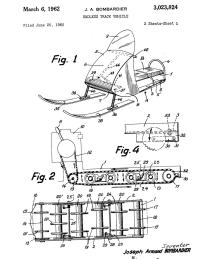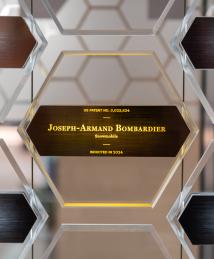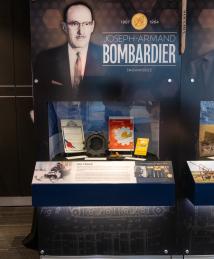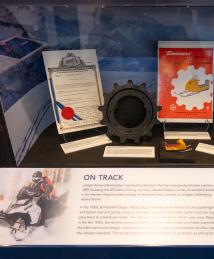Joseph-Armand Bombardier
Joseph-Armand Bombardier invented the Ski-Doo® snowmobile in 1959. It was the first mass-produced snow machine, and it launched snowmobiling as a sport and recreational activity.
Bombardier was born in 1907 and grew up in Valcourt, Quebec, Canada. He showed an early aptitude for designing and modifying mechanical devices to turn them into mobile toys, such as a miniature locomotive, tractors and boats. After attending Séminaire Saint-Charles-Borromée in Sherbrooke, Quebec, he opened his own machine shop in Valcourt in 1926. He understood the challenges of living in rural, isolated villages in winter, when the snow made unplowed roads impassable. Over the next decade Bombardier spent his spare time developing various motorized vehicles to travel on snow.
He encountered many challenges, including weight and propulsion. A vehicle needed to be light enough to travel over snow and its changing consistency. At the time, only heavy motors existed on the market. He put the motor in the back of the vehicle and redistributed the weight over a track and wheel system. A pair of front-mounted skis directed the vehicle left and right. For propulsion he added a rubber-covered sprocket to pull the track. This allowed his big vehicles to “float” over snow.
In 1937, he obtained his first patent, in Canada, for this sprocket wheel/track system. With this in hand, he concentrated all his time on building snow vehicles. That year, he introduced the B7 model, which carried seven passengers in an enclosed compartment. Through the years, he continued perfecting his vehicles and obtained different patents. He made the 12-passenger B12 snowmobile, and the C18 with a capacity of 18 adults or 25 children. These vehicles had many uses, such as delivering mail and goods and operating as school buses.
Bombardier incorporated his business in 1942 as L'Auto-Neige Bombardier Limitée. The company sold several hundred vehicles a year until the late 1940s, when the Quebec provincial government began plowing all rural roads and the demand for large snow vehicles declined significantly. The company adapted by producing tracked vehicles for farming, mining, logging and forestry, and petroleum exploration operations. In the 1950s, Bombardier also began producing his own tracks, which involved patenting his own process for vulcanizing rubber.
From 1957, Bombardier dedicated his time and resources to fulfill his lifelong dream of a smaller and faster snowmobile. At this time, several manufacturers had begun to offer lightweight, powerful, affordable gasoline engines, which proved to be essential for designing smaller snow vehicles. Bombardier and his staff used a small engine and applied their own innovative designs for other mechanical components as they introduced the first rider-over-tunnel design, where the rider straddled an elongated seat and steered a pair of front-mounted skis. Behind the skis, a single wide, seamless track enabled the sled to "float" on the snow at high speed.
When Bombardier brought a working prototype to an Ontario missionary outpost in 1959, the first lightweight, maneuverable vehicle was so popular with everyone who tried it, he chose to donate it to the mission and was inspired to pursue the idea of using snowmobiles for recreation as well as for work. Bombardier’s small, affordable vehicle, originally called the Ski-Dog, went into production as the Ski-Doo snowmobile in late 1959.
The International Snowmobile Hall of Fame, which later inducted Bombardier, described the Ski-Doo snowmobile as “the first mass-produced over-the-snow machine [...] recognized worldwide as the pioneer design that created the sport of snowmobiling as it is known today.” The vehicle’s rider-over-tunnel design became the industry standard, and as snowmobiles became popular for recreational use, an estimated 136,000 miles of signed and maintained snowmobile trails in North America have since been developed by snowmobile clubs and associations.
Bombardier Inc., the successor to L'Auto-Neige Bombardier Limitée, diversified after Bombardier’s death and is a global leader in aviation, focused on designing, manufacturing and servicing business jets. Bombardier’s legacy is celebrated in his hometown of Valcourt at the Musée de l’ingéniosité J. Armand Bombardier and through the Fondation J. Armand Bombardier philanthropic activities. Valcourt is also the corporate and manufacturing headquarters for BRP (Bombardier Recreational Products), which became an independent company in 2003 and is a worldwide leader in recreational vehicles. Joseph-Armand Bombardier held 16 U.S. patents.
10 Things You Need to Know About Joseph-Armand Bombardier>>>



